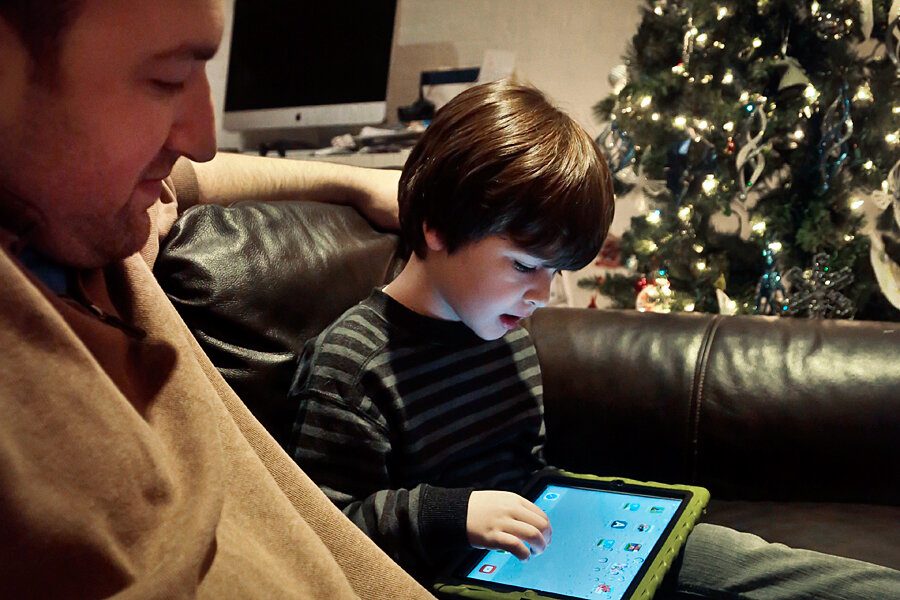Do tablets teach? Parents see mobile devices as underachievers, study finds.
Loading...
Despite an explosion in the number of educational apps marketed for preschoolers and elementary school-aged children, parents see their young children spending relatively little time learning on mobile devices, according to a new report from the Joan Ganz Cooney Center at Sesame Workshop, a nonprofit that researches and produces educational media for children.
The study, which surveyed parents about their 2- to 10-year-olds’ media use, found that while 65 percent of children use mobile devices, only 9 percent play what their parents describe as “educational” mobile games daily, and only 35 percent use educational apps even weekly.
Overall, while the time spent with screens increases as a child ages, the proportion of educational screen time drops dramatically. Parents label 78 percent of 2- to 4-year-olds’ media consumption as “educational” but only 27 percent of the media consumed by 8- to 10-year-olds.
“I had expected a drop-off by age,” says Vicky Rideout, the media researcher who wrote the report, “Learning at home: families’ educational media use in America.” “But the magnitude of the decline [in educational use on mobile devices] and how young it happens was surprising to me.”
The availability of mobile devices has skyrocketed in recent years, even among the lowest-income demographics: 71 percent of all 2- to 10-year-olds live in homes with at least one smart phone, as do 57 percent of those living in families making less than $25,000 a year, according to the report.
But when it comes to screen time for children, television is still king. Young children consume 2 hours, 7 minutes of screen time a day on average, according to the study. Television accounts for 1 hour, 21 minutes of that total.
“iPads are such an exciting new tool,” Ms. Rideout says. “They are especially exciting within the educational media community because they’re such a great platform – there are so many capabilities. But we do also need to keep our eye on what is happening in kids’ lives right now. Even with the love kids have with smart phones and iPads, they’re spending a lot more time with television.”
Forty-five percent of 2- to 4-year-olds watch what their parents describe as educational television or DVDs every day, compared with 12 percent of the same age group who play educational mobile apps.
Despite talk of a new “app gap,” in which wealthier, white children benefit more from screens than minorities and children from lower-income families, the Cooney Center survey found that lower-income parents report their children to be more frequent users of educational media than do their wealthier counterparts.
Fifty-seven percent of lower-income children’s screen time is educational, according to parents, compared with 40 percent among the wealthiest demographic of children. Meanwhile, black parents are far more likely than whites or Latinos to say their children have learned “a lot” or “some” from screen media about math, social skills, reading, and other subjects.
But these conclusions, child development experts point out, could be as much about parents and their perceptions of education than about what children are really learning.
“One of the issues and confusions for parents is that education is often defined as learning facts and not about learning how to learn – and learning how to learn is what young children really need,” says Susan Linn, co-founder and director of the Campaign for a Commercial Free Childhood.
“They need to have their curiosity nurtured,” she says. “They need to believe they have the capacity for experimentation and exploration. They need to be creative problem-solvers. Those are the kinds of skills children develop through unstructured, hands-on, creative play.... There aren’t a lot of media programs out there that help children learn how to learn.”
The Cooney Center report is one of the first to try to quantify children’s consumption of educational media – an effort Rideout says she knew would be fraught.
“You could get two experts in a room and they could disagree about whether the show was actually educational or not,” she says.
But Lisa Guernsey, director of the New America Foundation’s Early Education Initiative and author of a book about screen time and young children, says the report is a good first step – at the very least, a way to get parents and educators talking about the ever-growing amount of screen media targeting children.
“There is a huge amount to unpack in terms of what parents understand about what’s education – and even about what researchers and scientists understand about education,” she says. “But I think it’s really important to start this conversation.”






